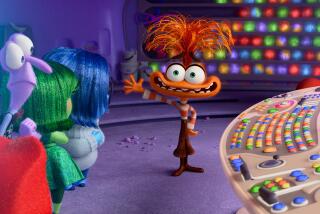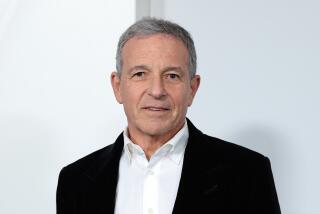Pixar, with ‘Toy Story 3,’ shows increasing reliance on sequels
Pixar Animation Studios, the pioneering digital studio that long prided itself on creating novel stories and characters, is now treading a well-worn Hollywood path.
Three of the company’s next four releases are sequels.
On Friday, Pixar debuts the highly-anticipated third chapter of its popular “Toy Story” saga, to be followed in the next two years by new installments of “Cars” and “Monsters, Inc.” Pixar won’t have another original movie until 2012, when “Brave,” about a young Scottish girl of royal blood who dreams of becoming a champion archer, arrives in theaters.
The surfeit of sequels for a studio that had produced only one —”Toy Story 2”— since its first movie premiered 15 years ago, marks an important turning point for Pixar, which was acquired in 2006 by Walt Disney Co. It also shows how the Northern California-based digital animation pioneer, which has held itself aloof from the grubby realities of Hollywood, is any longer immune from the economic laws of the entertainment marketplace.
“Pixar was always very adamant about creating original stories with original characters,” said Jill Culton, an animator and story artist who worked on many of Pixar’s early hits, including the first two “Toy Story” films. “A real big draw to working at Pixar is it’s riskier developing original properties as opposed to pre-existing books or fairy tales that already have a built-in audience.”
In a business where the typical studio is considered to be on a red-hot streak if it produces two hits in a row, Pixar has existed on an other-worldly level. It’s films consistently have been critically lauded — five have won Oscars for best animated feature, including the last three years, and “Up” was also nominated for best picture this year. And not one has done less than $360 million in worldwide ticket sales, a rare marriage of art and commerce.
But commerce, and plenty of it, is the guiding rule of Disney under the stewardship of Chief Executive Robert Iger. He is fashioning Disney, once principally concerned with family entertainment, into a consumer giant built around “brands” and “franchises,” whether it’s the fourth “Pirates of the Caribbean” movie or this year’s $4-billion acquisition of Marvel Entertainment, the historic comic book company that spawned the “Spider-Man,” “X-Men” and “Iron Man” movies.
“Toy Story 3” “represents a big step for the company,” Iger said Wednesday. “It’s a very important franchise for the company. When we bought Pixar in 2006, one of the big results was that ‘Toy Story 3’ would be produced by Pixar, so we’re very excited.”
So are moviegoers. Marketing surveys point toward a opening weekend of at least $70 million at the U.S. box office, a sign fans are looking forward to the latest “Toy Story” movie. Early reviews have been positive, too, albeit it’s not being hailed as an artistic achievement on the level of “Wall-E” or “Up.”
“Toy Story 3,” which has Andy grown-up and going off to college and leaving Buzz, Woody and the rest of his prized toy collection to be donated to a daycare center, is expected to be a bright spot in an otherwise bleak summer. There has been strong buzz about the movie since March, when theater owners raved after seeing it at their Las Vegas convention.
Not only does Hollywood view sequels as safer bets because audiences are pre-disposed to seeing the next installment of a successful series, but the familiar characters also can generate hundreds of millions of dollars in business beyond the box office through sales of DVDs, consumer products and theme park tickets.
This month “Toy Story 3” was the centerpiece of Disney Consumer Products group’s presentation at the annual merchandise licensing show. The film introduces a spate of new characters, including a thespian hedgehog, Mr. Pricklepants, Trixie the triceratops, and the deceptively folksy Lots-o’-Huggin’ Bear. Disney executives projected that sales could reach $2.4 billion this year, adding to the $9 billion worldwide that the franchise has generated to date.
Lutz Muller, president of Klosters Trading Corp., a market research company that specializes in toys and video games, said toymakers like Mattel or Hasbro prefer proven film properties — like “Toy Story” — over original stories such as “Wall-E.” Manufacturers must pay a hefty license fee and guarantee minimum royalty payments for toys spun-off from movies, making them disinclined to take risks on untested properties. And retailers take their buying cues from toymakers when allocating shelf space to toys, he said.
“With an untested film, they are cautious if it doesn’t have incredible box-office predictions,” Muller said.
Indeed, the emphasis on bankable movie franchises was precisely what Disney had in mind when it agreed to pay $7.4 billion for the Emeryville, Calif., studio that was controlled by Apple Inc. Chief Executive Steve Jobs. The agreement anticipated that Pixar would step up the number of films it produces and “make more sequels,” according to two executives familiar with the deal.
But unlike “Toy Story’s” Andy, who’s experimenting with his first taste of freedom, the long-independent Pixar is adjusting to life under the thumb of its corporate parent. The studio that revolutionalized animation by replacing hand-drawn cartoons with computer-generated images, is learning to learning to balance to critical achievement and commercial appeal.
“Pixar is part of a large corporate culture that they have to accommodate,” said former Disney animator Steve Hulett, business representative for Hollywood’s animation guild, which doesn’t represent Pixar animators. “Disney is not running a renaissance art studio, they’re out to make money — big money — and they’re upping the odds by producing sequels.”
Pixar creative chief John Lasseter, who directed and co-wrote the first two “Toy Story” movies, in the past has cited the well-received “Godfather 2” as the standard for how sequels should be made, that is, only when there is a compelling new story to be told (the third Godfather movie is widely regarded as an embarrassment).
At the June 13th premiere of “Toy Story 3” at Disney’s El Capitan Theatre in Hollywood, Lasseter dismissed concerns about the proliferation of sequels at Pixar, saying that the studio had always wanted to create follow-ups with popular characters.
But those efforts were complicated by its original distribution deal with Disney made prior to the acquisition.
The contract stipulated that sequels did not count under the multi-picture arrangement. Former Disney Chief Executive Michael Eisner insisted on sticking to the provision, but Jobs balked. Though 1999’s “Toy Story 2” grossed $485 million worldwide, it was not counted as one of the five films Pixar was to deliver under the deal. Jobs refused to make a third Toy Story movie unless it did count toward the total.
The feud contributed to the breakdown in relations between Disney and Pixar, leading Jobs to sever ties with the Burbank studio in 2004. Disney, which owned sequel rights to the Pixar movies, then announced plans to make “Toy Story 3” and other sequels on its own.
The studio went so far as to create a dedicated sequels unit in Glendale for that purpose. At that time, Disney said that it also planned to make sequels to Pixar hits “Finding Nemo” and “The Incredibles.”
After the acquisition, Disney’s then-new chief executive, Iger, halted the studio’s plans to proceed with “Toy Story 3” without Pixar, and shut down the operation dubbed by detractors as “Pixaren’t.”
More to Read
The biggest entertainment stories
Get our big stories about Hollywood, film, television, music, arts, culture and more right in your inbox as soon as they publish.
You may occasionally receive promotional content from the Los Angeles Times.










